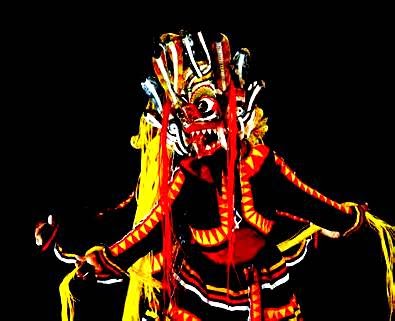Come with me and do the devil mask dance in Sri Lanka! Elsie Gabriel
I loved the drama, the entertainment, historic
ritual and of course the anthropology involved in the beautiful colorful
‘masks’ worn during the charade. Sri Lanka is fascinating. An island famous for
its pristine beaches and wild life, you have to give in to the ancient cultural
mythological stories when it comes to the history of ‘Masks’. Masks used in
various dramatic rituals in Sri Lanka can be classified as demonic,
animal-spirit and human figures. The significance and designs of mythological
masks are associated with iconography of the folk religions of the historical
period.
The Mask
dance is said to have been a carefully crafted ritual with a history reaching
far back into Sri Lanka’s pre-Buddhist past. The Lankans love their visual art
and the ‘Mask’ is one highly coloured and revered piece of artifact used in
religious ceremonies as well as entertainment. The masks are mainly made from a durable wood called ‘Kaduru’. The wood is light and allows carvings to be
made very easily.
The ‘mask’ rules in most ceremonial and devotional performances. The use of masks in rituals and ceremonies is a very ancient human practice across the world, although masks can also be worn for protection, in hunting, in sports, in feasts or in wars or simply used as ornamentation. Some ceremonial or decorative masks were not designed to be worn. Although the religious use of masks has waned, masks are used sometimes in drama therapy or psychotherapy.
If you ever
go to Sri Lanka do not miss the ‘devil mask’ dancing which is generally
performed with the motive of healing. These are also accompanied by drummers, to
enhance the accompanying crazy steps and movements of dancers wearing the geometrically
brightly coloured masks.
It is an extraordinary
cultural phenomenon .Mask dancing and drama are mostly attempts at invoking the supernatural. But the most
elaborate masks are for drama.
It is more like an opera, having a central theme and a series of episodes
enacted by dances wearing masks of different sizes, culminating in the dramatic
presentation of a story.
Try and find a local Mask maker and see how well it is chiseled,
crafted and painted. Each one is a master piece!
By hiding your
face the mask allows you to play a totally different role, it gives you the
liberty to assume another personality. It is symbolic and magical, anonymous
and mysterious.Well when I
danced the mask dance in Sri Lanka, I felt liberated; the mask did not hide my
persona but accentuated my feeling s of freedom.
Try one next time.
Think of
it, the Mardi
gras, the African cultures, South Indians and Chinese dragon mask dances all simply celebrate cultural well being!
gras, the African cultures, South Indians and Chinese dragon mask dances all simply celebrate cultural well being!











No comments:
Post a Comment
http://mytravefootprints.blogspot.in/